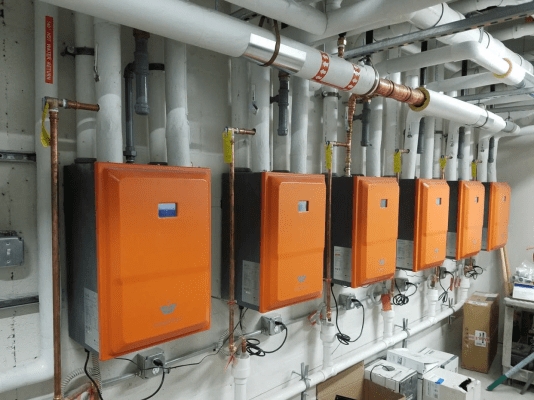Intellihot stokes a more efficient fire under your office boilers – TechCrunch
Founded in 2009, Intellihot has been on a mission to make commercial buildings more efficient, by improving the cost and physical footprint of keeping building H2O nice and toasty. The company just announced it raised $50 million to shake up the $81 billionn global HVAC market, with plans to expand internationally. The round was led by investors Aegon Asset Management and the Avenue Sustainable Solutions Fund.
When you walk into an office building, you see security guards, fancy company plaques on the walls and, around this time of year, you may see a Christmas tree or two. What you don’t see is what happens deep in the bowels of a building, and if you’ve never paused to think about the vast amount of magic that happens under the floors, in the walls and along the ceilings of a building, you’ve probably not thought about what an incredibly complex creature a modern office building can be. Apart from the immediately obvious — electricity, internet and an endless and deeply necessary supply of caffeinated hot beverages — buildings need hot water.
“Paradoxically, hot water access is everywhere, necessary and yet easy to overlook — until you don’t have it anymore. Intellihot has recognized the enormous opportunity at hand to integrate hardware and software into a smart, environmentally sustainable solution to improve how commercial facilities use hot water,” said John Larkin, head of Impact Investments and co-manager of the Avenue Sustainable Solutions Fund. “Intellihot reflects well upon our strategy to partner with great businesses that can deliver financial performance along with beneficial outcomes for society and planet.”
As Larkin points out, if the hot water stops flowing, things very quickly get unpleasant. The challenge with hot water is that usage is incredibly time-specific. If the building has apartments or gyms in it, 7 am is a huge peak, and if the hot water runs out, the building managers’ phones won’t stop ringing. Unfortunately, it’s also painfully expensive to heat water and to keep it hot, especially at times where hot water usage is lower than usual. Intellihot is addressing all of the above, using tankless, on-demand water heating solutions for a wide range of commercial buildings, including hotels, restaurants, stadiums, hospitals and more.
“You know, truly we started it as outsiders, with no connection to the industry. I am passionate about energy loss; every time I see the radiator or a tailpipe on a car, I know that its singular purpose is to heat the environment,” explains Sridhar Deivasigamani, founder and CEO of Intellihot. “I felt the same thing when a water heater broke at my house. And since then, we have totally reinvented how water is heated and delivered.”
In a lot of applications, having a large tank of water means that hot water is instantly available while more water is being heated up. That’s convenient and serves as a buffer, but it is also spectacularly expensive to keep a large tank of water at temperature. In residential homes, Consumer Reports is seeing an increase in the popularity of tankless, on-demand water heaters, but for commercial buildings, the adaptation has significantly lagged behind. One of the biggest challenges in this space is that a lot of planning and engineering goes into building and upgrading medium to large commercial buildings. When the buildings are designed, the space allocated to hot water is typically designed for water tanks — which have an 80% larger footprint than Intellihot’s heaters. Once the space is there, and the energy cost of heating the water is calculated into the overall energy expenditure of the building, there hasn’t traditionally been much incentive to switch to a tankless solution — but that is very slowly starting to shift.
“We are the first new startup in this space in almost 100 years,” claims Deivasigamani. “If you look at the big three companies in this space, they all started in the late 1800s. So you have generations and generations of builders, building engineers and contractors thinking this is the only way it can be done.”
Of course, the incumbents are also starting to produce tankless heaters, but Intellihot believes it has an edge in the approach it takes.
“Equipment always breaks down on a Friday night, and 90% of equipment is replaced when there is an emergency. That’s not ideal. If you’re a Chipotle or Starbucks, the solution today is to double up the number of equipment they have. That’s not great for the environment. We have an alternate approach: we launched a piece of equipment that is called Tellibot AI,” explains Deivasigamani. The equipment connects to water heaters to gather data based on flow, heating patterns, etc. You install it for 10 days, and the company will analyze the data and give you a projection for how long the existing equipment will continue to perform. The goal is to give building owners a chance to replace water heaters as scheduled maintenance, rather than at the worst possible time, at exorbitant 24-hour-call-out rates.
Intellihot has its equipment installed “in thousands of buildings,” its CEO told me, including hotels, multi-family residential buildings, senior living facilities, hospitals and more. The company claims it has logged more than 670 million hours of operation without failures.

